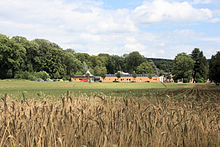House to the mills
Haus zur Mühlen is a district of the city of Siegburg . It is a tufa mill property with towers, which was first mentioned in 1312 in the possession of Michaelsberg Abbey . The house was given the right to a seat in the Bergisches Landtag until around 1806 and was included in the Rhenish provincial estates as a manor in the 19th century. Today the property is used as a retirement home after being used as a monastery.
history
Since the house was outside the Siegburg castle spell and the Vogtei Wolsdorf in the area of the Office Blankenberg , the property may have been owned by Michaelsberg Abbey since it was founded. In 1369, the owner of the knights, Johann von Attenbach, was granted mill compulsory rights by the Duke of Berg for the judicial district of Wolsdorf and the villages of Kaldauen , Schneffelrath , the Höfe an der Heide, Rodenbach, Schmitthof, Leyhorst and Junkersbroich.
When the knights of Attenbach died out, the castle house fell in the 16th century to the lords of the Reven, who in turn sold it in 1618 to the lords of Gevertzhagen, who were now the new lords of Attenbach . After the last member of the family died in the siege of Kaiserswerth in 1690 , the inheritance fell to Philipp Adolf von Wittmann after the death of his widow. But since he became mentally ill and the appointed manager ran down the property, it had to be auctioned. The new owner was Raban Wilhelm von Wecus on April 26, 1735. Heir was his daughter Elise, who was married to the Cologne art collector Everhard Oswald Freiherr von Mering. Her son, the historian Dr. phil. Friedrich Everhard von Mering , described the house in which he spent his childhood as follows: "You can only get to the front door via a stone bridge." He dates the empire-style house, which he describes as being surrounded by a large garden and ponds, to the year 1760. After it was inherited by his son-in-law, the Russian baron master von Kezelli, it came into the possession of Johann Neuhöffer in 1827 . The carousel of the owners was now turning faster and faster, because in 1845 the topographer JP Weyer, in 1846 the von Klitzing and in 1857 the princes of Salm-Horstmar .
On July 1, 1930, the estate was bought by the Cologne Alexians for 300,000 gold marks as a farm for agriculture and livestock. In the same year the community began building a chapel, which was then consecrated to St. Joseph on April 2, 1931. A new farm building, a monastery building and a ward for about 100 patients were completed shortly afterwards. At that time, the buildings were completely outdated and the regular victim of small fires. Former Neuss patients and residents were housed in the cloister section above an archway, so that a closed cloister area was not set up again until the 1980s, but now on the second floor of the manor house. After the agricultural buildings finally fell victim to the flames, an old people's home for around 100 residents was built on the site of the former business enterprise and the Empire-style mansion was converted into a purely closed building. When the convent was broken up in the first third of the 1990s due to resignations and transfers, the province moved the novitiate to Aachen in March 1994.
literature
- Ernst Weyden : The Siegthal. A guide from the mouth to the source of the river and through its side valleys. At the same time a manual for travelers on the Deutz-Siegener Railway. Topographical-historical sketches along with statistical and natural history suggestions. Adolf Lesimple's Verlag, Leipzig 1865, p. 132, digitized version, (revised new edition of the 1866 edition: Edition Verlag Blattwelt, Niederhofen 2009, ISBN 978-3-936256-39-0 ).
Web links
Coordinates: 50 ° 47 ′ 59 ″ N , 7 ° 14 ′ 30 ″ E



